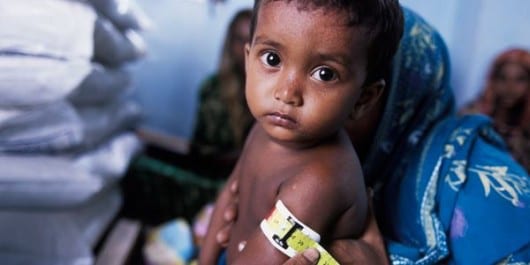The two-year old child in this photo presents to your health center in the Democratic Republic of the Congo. Family members explain that eight months ago their farm was attacked by bandits. No one in the family, including this child named Aamir, has eaten regularly since then. What’s more, Aamir in recent days has developed fever, diarrhea and lethargy.
On initial physical examination you note that Aamir is poorly responsive to stimulation. His temperature is thirty-eight degrees C, respirations are thirty per minute, pulse is ninety, and blood pressure is unobtainable. He has extreme muscle wasting throughout and loss of adipose tissue but no peripheral edema. Aamir’s measurement of mid-arm circumference and skin fold thickness are well below the norms. Your diagnosis is marasmus.
Your FIRST priority in the management of this child with acute protein-energy malnutrition (PEM) is which ONE of the following:
A Treatment of coexisting fever and diarrheal illnesses
B Provision of high-concentration protein supplement
C Administration of micronutrient supplements
D Immediate refeeding
E Correction of hydration and acid-base alterations
Explanation: The correct answer is E. The management of acute PEM can be separated into two stages. The first stage is stabilization, to immediately correct hydration and acid-base alterations. The second stage is refeeding. This can begin as soon as medical problems are reasonably stable and rehydration is complete. It may be necessary to begin initial refeeding slowly in persons who have advanced PEM or kwashiorkor because of damage to the intestinal mucosa. During the period of renutrition, micronutrient supplements and attention to any coexisting medical illnesses may also be indicated.
Ten days later, Aamir, is alert and being fed F-100 – a 100 kcal/100 ml formula made from concentrated milk powder, food oil, and dextrin. During the coming weeks your care of this malnourished child will include which ONE of the following:
A Vitamin A supplementation
B Nutrition education to avoid legumes
C Removal of hookworms from feet
D Avoidance of vitamin C
E Provision locally mined salt
Explanation: The correct answer is A. The mainstay of therapy is continued administration of high energy, high protein food. Children of this age should also receive Vitamin A supplementation from prevention of xerophthalmia. Legumes are an important source of energy, though they may be deficient in iron. Hookworm initially penetrate the feet but reside in the intestines, requiring oral treatment. Vitamin C is important to aid in iron absorption. Non-commercially produced salt is unlikely to contain iodine supplement, contributing to iodine deficiency.
Would you like to take action on behalf of children like Aamir? Begin by arming yourself with the necessary knowledge and skills and experience though one of INMED numerous opportunities, including a supervised learning experience with one of our mentors in twenty-five developing nations. Be prepared when you care for a child like Aamir.

